Spicy Korean Beef Stew Cooks Illustrated
Yukgaejang is a deeply flavorful and comforting spicy Korean beef vegetable soup. My recipe includes step-by-step photos and top tips to make this satisfyingly spicy beef soup more authentic.
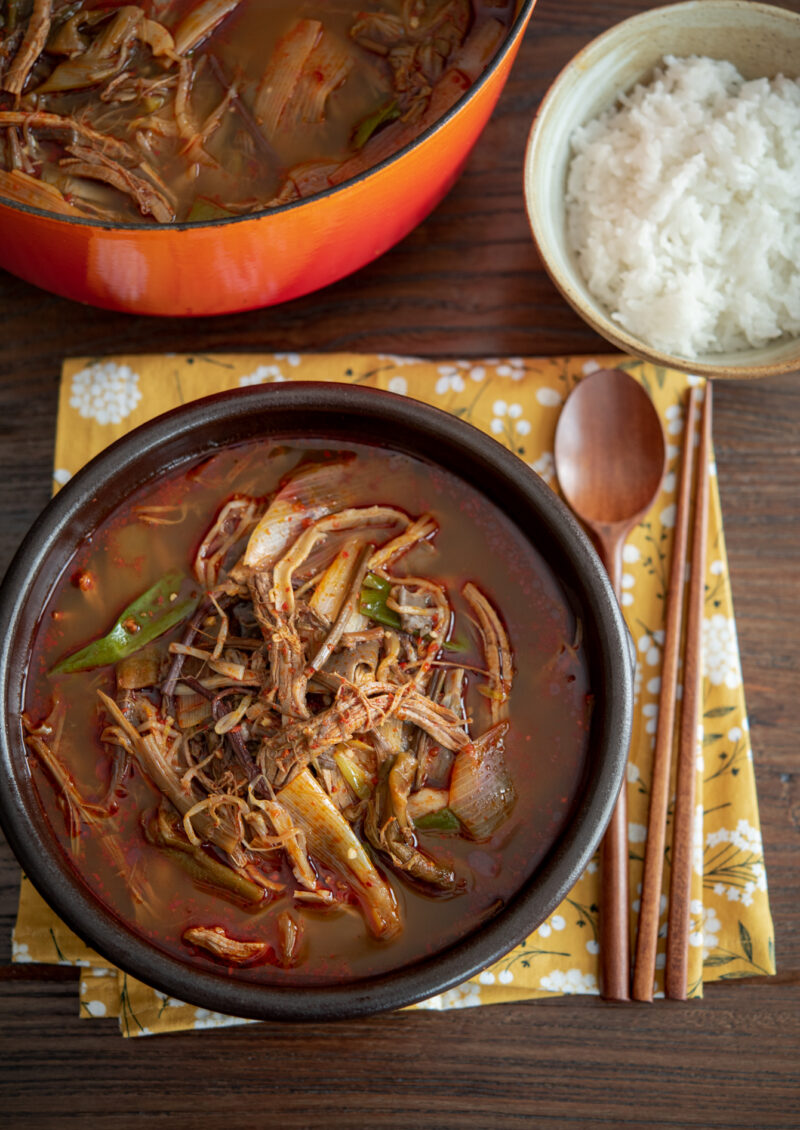
If you like beef soup, and especially if you don't mind a little spicy kick, don't miss out on Yukgaejang (육개장), Korean spicy beef vegetable soup recipe. Loaded with shredded beef and variety of vegetables in a flavor packed broth, Yukgaejang is a truly delicious and hearty soup that people crave once they've tasted it. Dakgaejang is another similar soup made with chicken.
I have to mention that making Korean beef soup while not complicated, takes time. In fact, you don't want a quick soup (stew) if you want to taste the deep flavor of this authentic Korean beef soup.
Beef brisket is simmered with onion, garlic, and radish to make the rich broth, and then the meat is shredded. Dry vegetables, such as fernbrake (gosari) and taro stem (toran), are simmered and soaked to re-hydrate. Fresh vegetables are also used to make authentic Yukgaejang.
If you are looking for a quick version, this is not the right recipe. However, this Yukgaejang recipe is not as difficult or complicated as you might think. Just remember my 4 cooking steps prior to making the soup, which I will explain below in the post.
Again, making traditional yukgaejang just takes some time. But it makes a big batch of soup that you can enjoy over and over. Some say it even tastes better on Day Two or Three. So, it's totally worth the time and effort if you ask me.
Just like any of my authentic Korean recipes, this soup will hit the Korean food cravings you might have. If you are looking for more classic Korean soups and stews, check out my cookbook "Korean Cooking Favorites."
Fun Fact about Yukgaejang
Do you know that Yukgaejang is one of the most sought-out dishes during the hot summer season in Korea? Interestingly it is a common practice for Koreans to eat really hot soups and stews during the summer to beat the hot weather outside. People believe drinking hot soup strengthens your heat tolerance for the summer. It makes you sweat so much while you are eating, you actually feel cooler to be outside after finishing the soup.
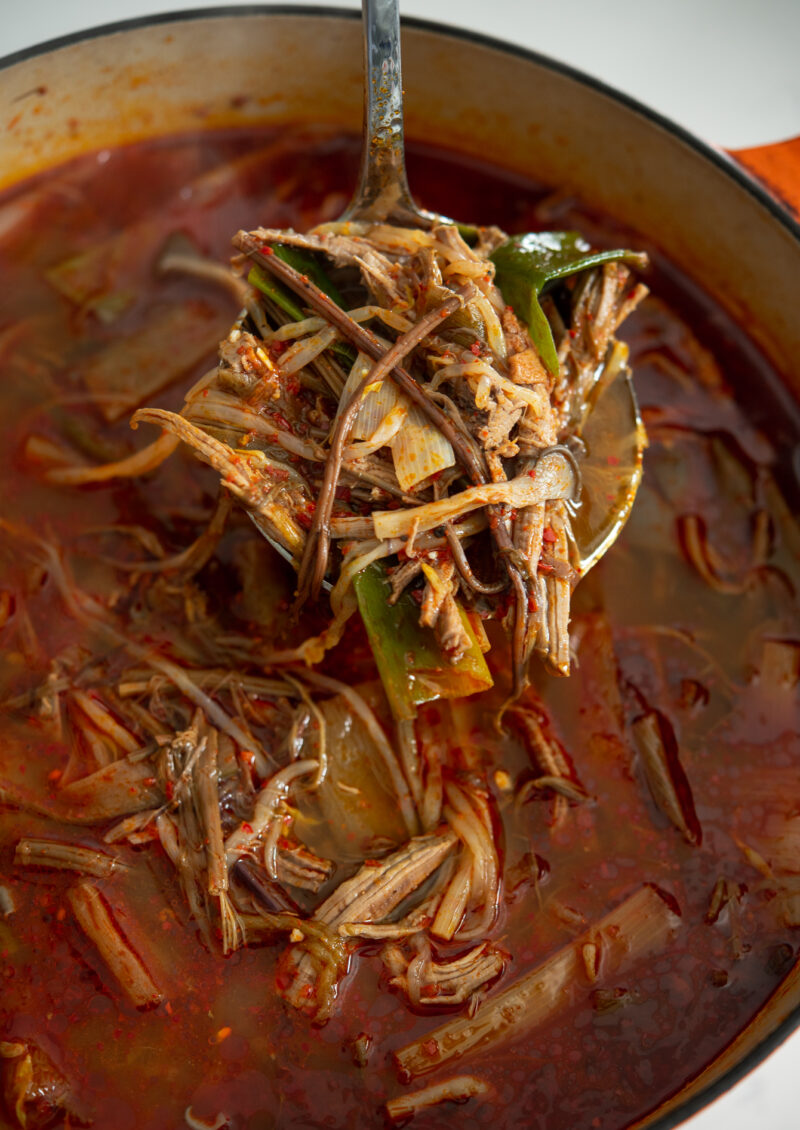
Recipe tips for homemade Yukgaejang
- Boiling Dried Vegetables: Boil dried fernbrake (aka bracken fiddlehead) and taro stem first, then soak them in hot water for 1 hr to re-hydrate.
- Make Beef Stock: Simmer together beef brisket, onion, whole garlic, and radish for 45 minutes to get the rich stock.
- Blanch Fresh Vegetables: Parboil mung bean sprouts, mushrooms, and Asian leeks in boiling water for 60 seconds to get rid of bitterness and sliminess.
- Chili Oil: heat through oil and Korean chili flakes over low heat, then coat the vegetables and beef before you start making the soup.
Once you have done these 4 steps of preparation before you actually make the soup, it only takes about 20 minutes of simmering to complete. Not too bad, right?
Dried vegetables in spicy Korean beef soup
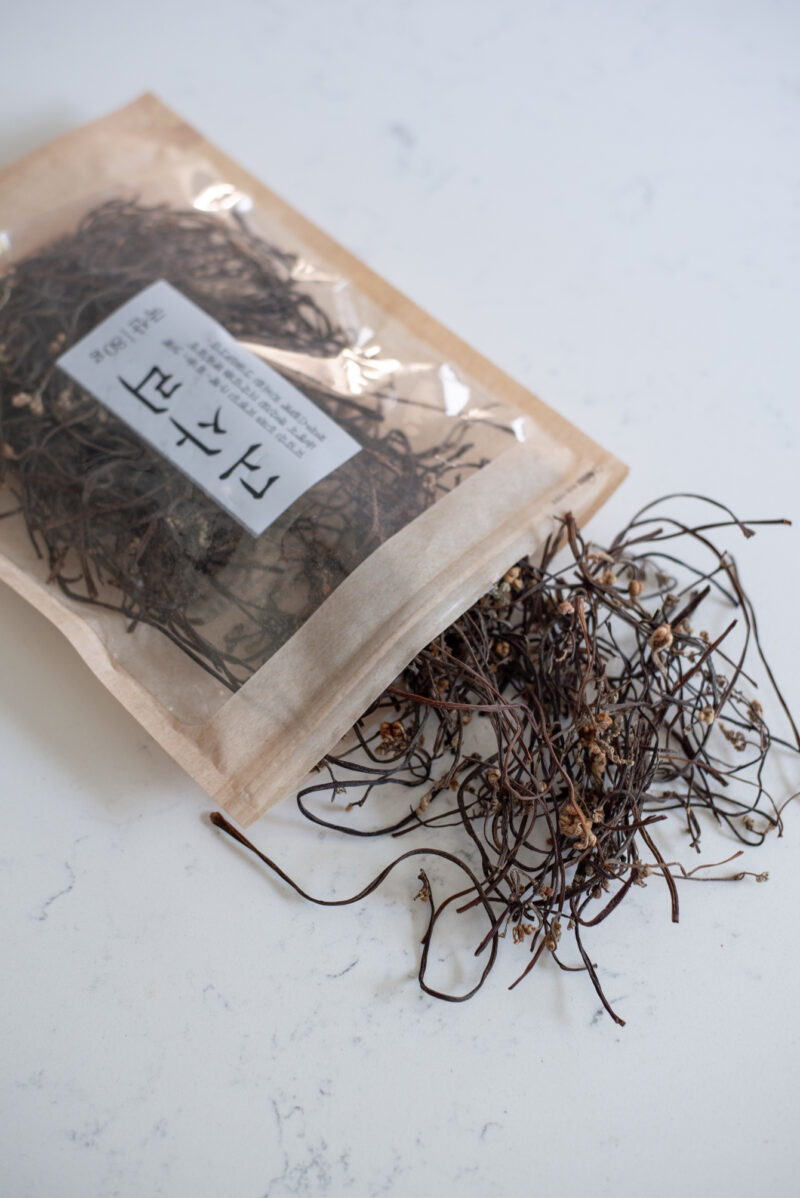
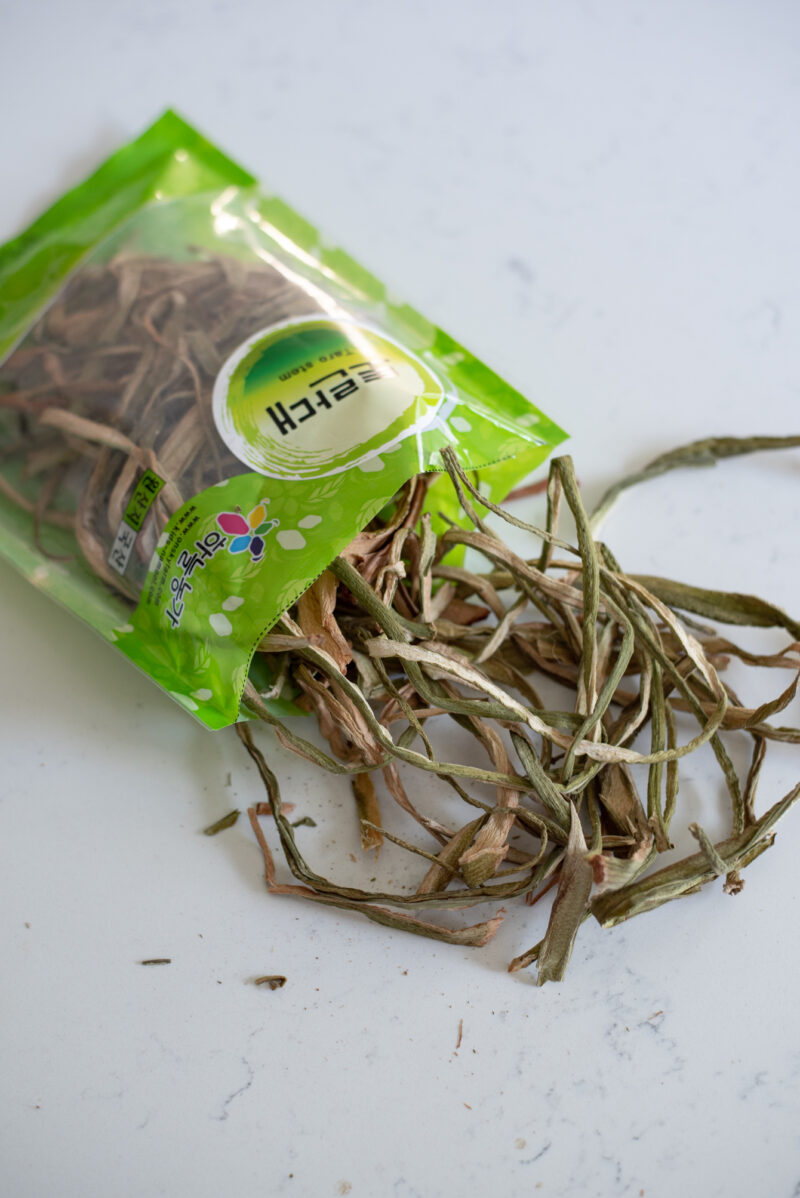
Dried fernbrake (gosari, 고사리) and taro stem (toran, 토란) are easily found in many Korean stores. They have a feather-light weight since they are dried. You only need about half bag of each for this recipe.
In order to re-hydrate, follow these steps. They will quadruple in volume once fully re-hydrated and cooked.
How to re-hydrate the dried vegetables for Yukgaejang
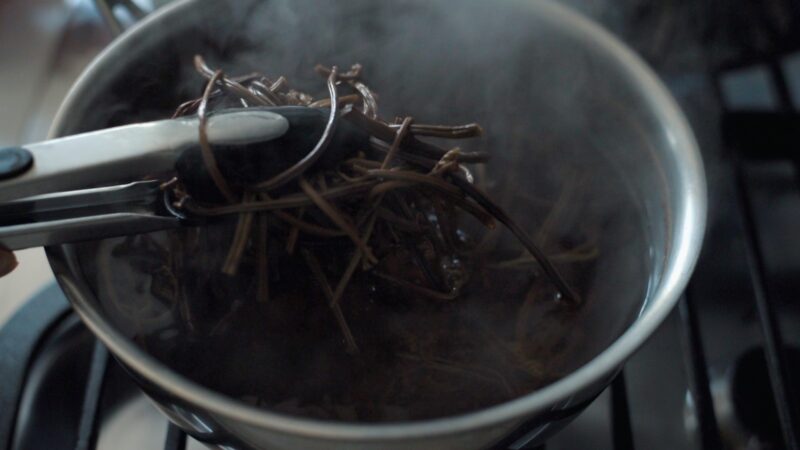
Add a desired amount of ferrnbrake in a pot filled with water. Bring to boil, then simmer for 20 minutes, covered. Remove the pot from heat and let fernbrake soak in the pot for 1 hour, covered.
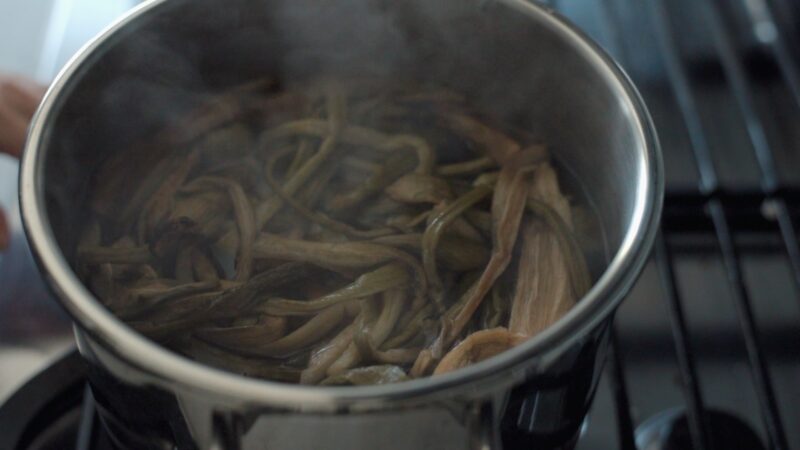
In another pot, cook the taro stem using the same method. Let it soak in the pot for 1 hour as well.
Drain the dried vegetables and rinse them in cold water several times. Squeeze out the extra water from the vegetables.
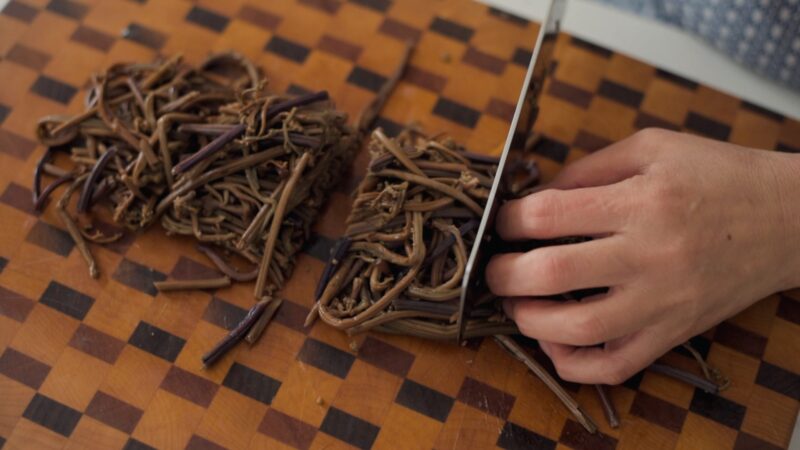
Cut fernbrake and taro stem in 2-inch slices.
Dried Ingredients substitution
Fernbrake and taro stem are hard to substitute with other types of vegetables due to their meaty and chewy texture. However, that doesn't mean that you can't make Yukgaeajang without them.
You can use shiitake mushroom in place for fernbrake, and increase the amount of leek and mung bean sprouts for the taro stem.
I have introduced a simpler version of yukgaejang recipe in my "Korean Cooking Favorites" cookbook that doesn't require these dried vegetables, so check it out.
How to make Korean Beef Vegetable Soup
Step 1. Make beef stock
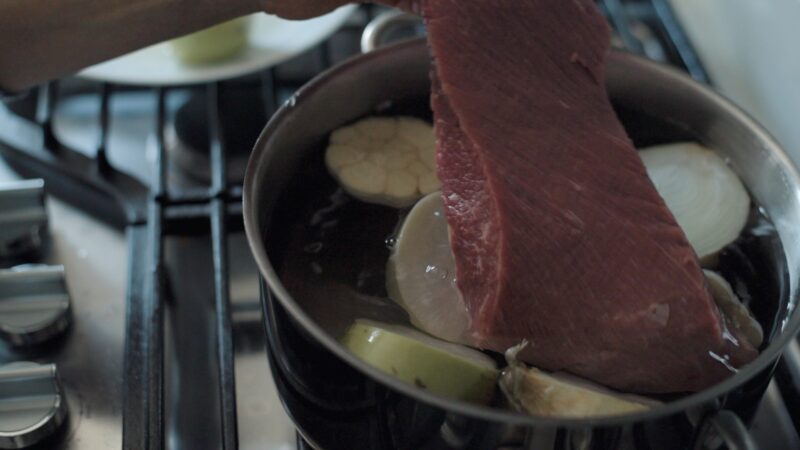
In a stock pot, combine onion, whole garlic (cut in half), chunks of radish and beef brisket. Add 14 cups of water to the pot and bring it to a gentle boil over medium high heat. Reduce the heat to low and let it simmer for 45 minutes.
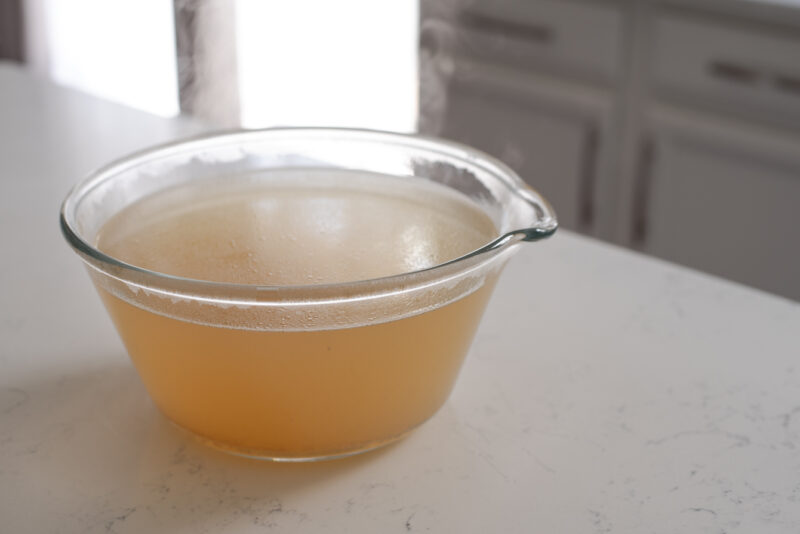
Discard the vegetables and reserve the beef. Strain the stock in a skimmer to collect any small particles. Reserve the stock.
Step 2. Blanch fresh vegetables
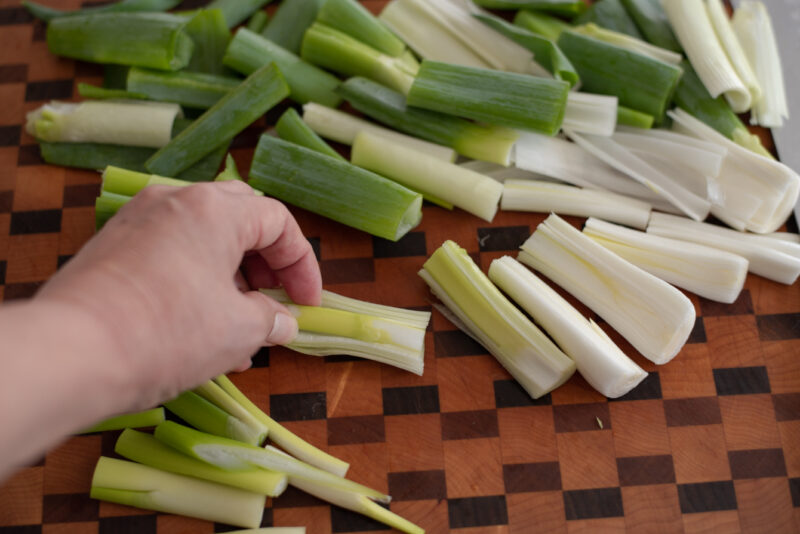
For the Asian leeks, cut them in half lengthwise, then cut into 2-inch slices. As an optional step, remove the pale green core in the center of the white parts of the leeks because they tend to be tough. You can leave it the way it is, if you wish.
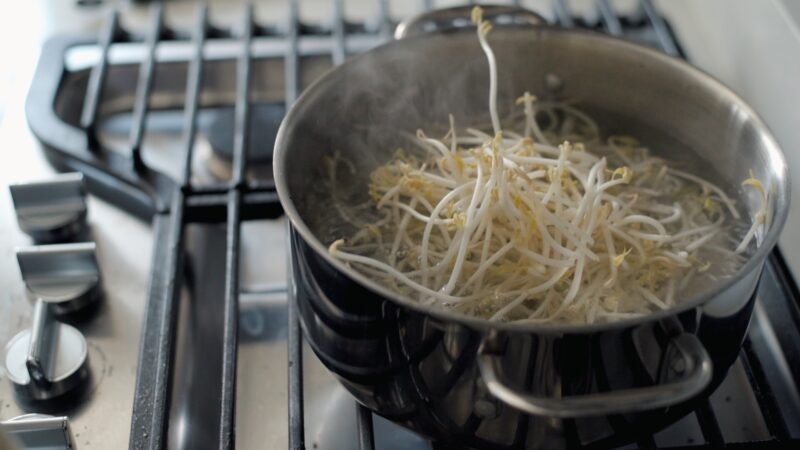
Bring a large pot of water to boil and sprinkle some salt. Add mung bean sprouts, stir, and wait for 10 seconds.
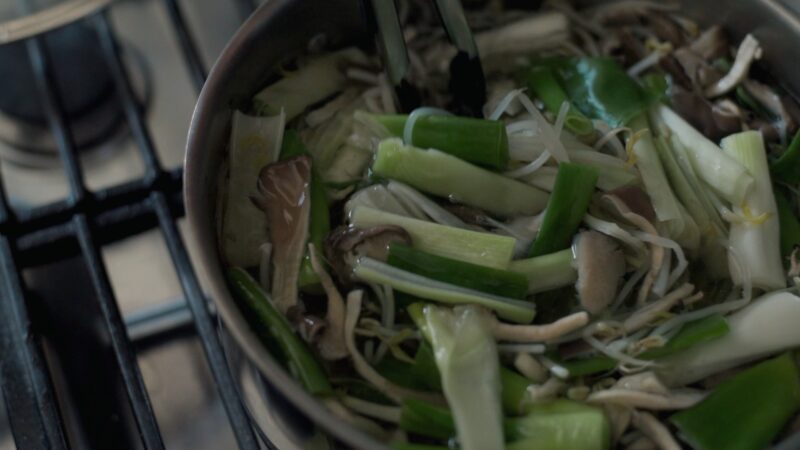
Add oyster mushroom and leek slices. Cook the vegetables for 10 more seconds. Drain and rinse the vegetables in cold running water. Squeeze out the extra water.
Step 3. Shred beef
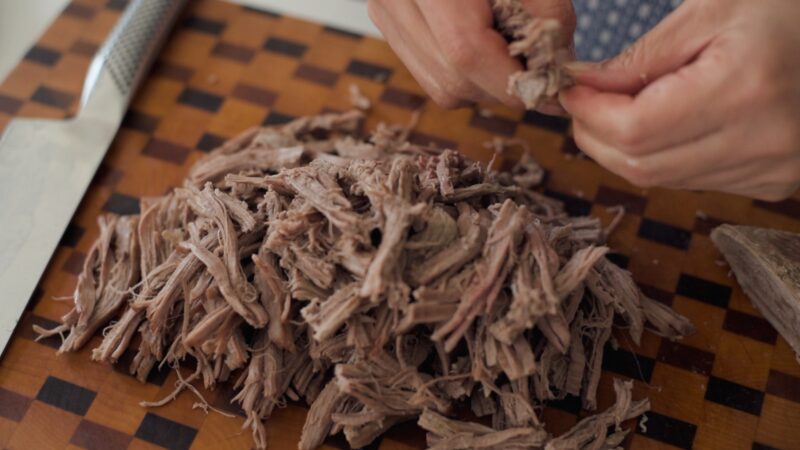
Shred Beef Brisket into bite size pieces.
Step 4. Make a soup with beef and vegetables
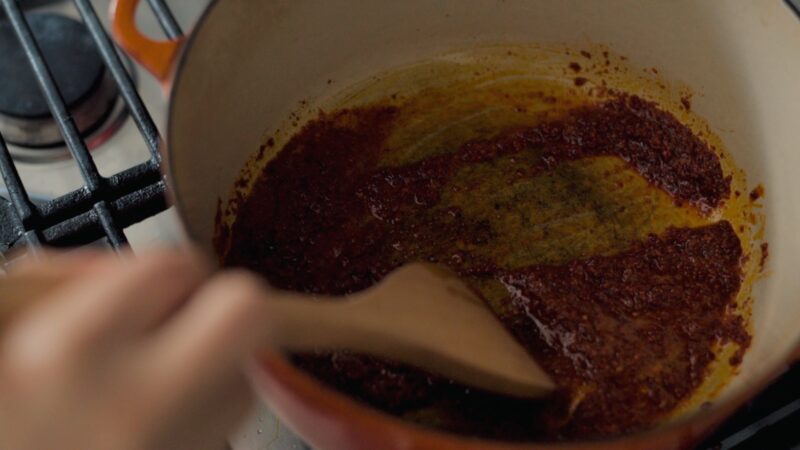
Heat oil and sesame oil in a large pot over low heat. Add the Korean red chili pepper flakes (gochugaru) and stir it for 30 seconds to release the fragrance and infuse the oils.
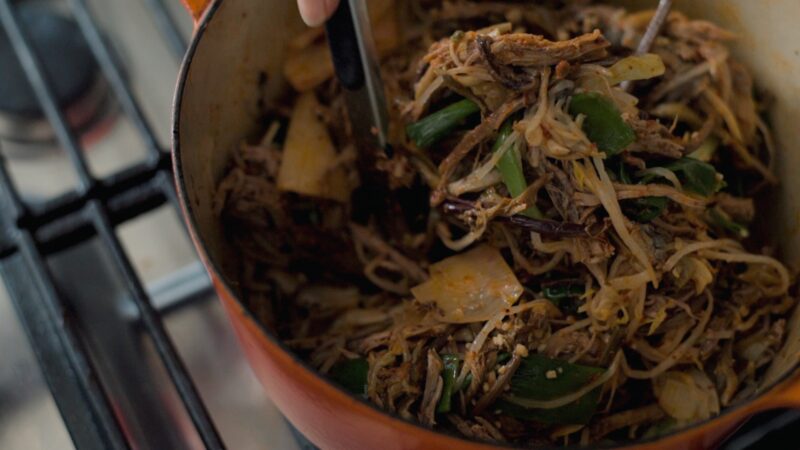
Add the vegetables and beef into the pot. Stir well to coat them with the chili oil.
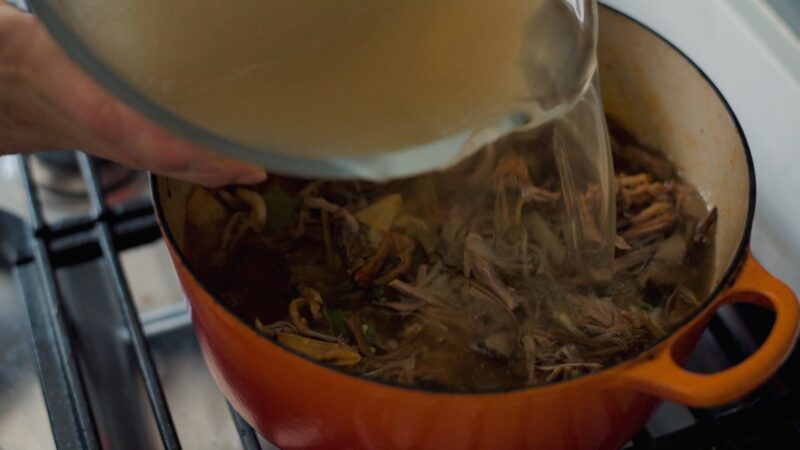
Pour the reserved stock into the pot. The amount of stock could be between 8-10 cups, depending on how thin you want your stew to be.
Step 5. Add flavors
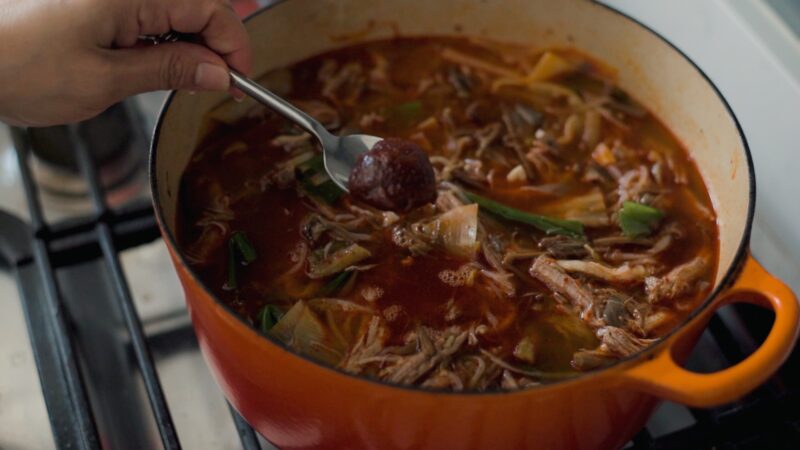
Add a teaspoon of Korean chili paste (gochujang) into the stew and mix well. Chili paste will help your soup to maintain its redness of broth without going dull. Cover the pot and let the stew simmer for 15-20 minutes over med-low heat.
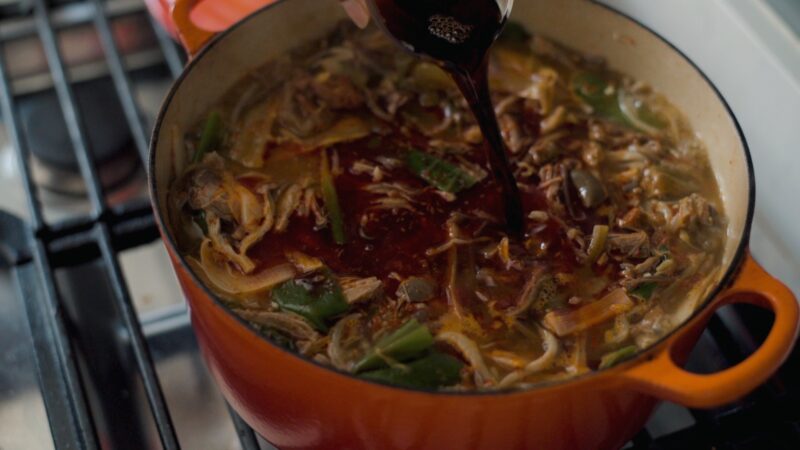
Season the stew with 3 different Korean sauces; soy sauce, Korean soup soy sauce, and Korean anchovy sauce.
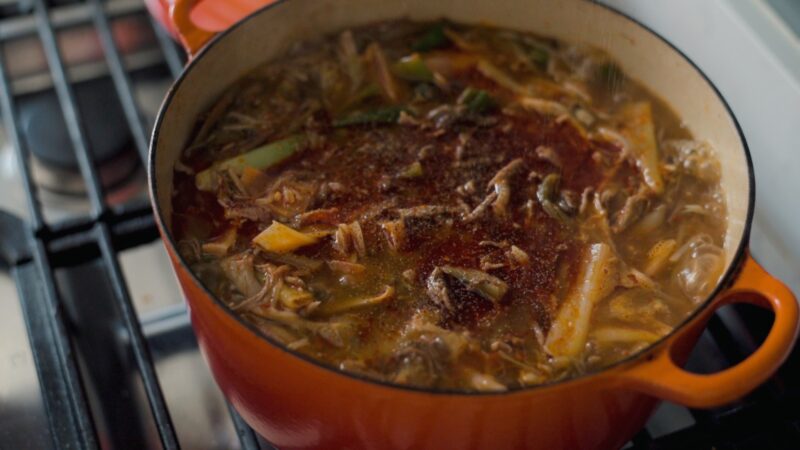
Taste the broth and add some salt, if needed. Lastly sprinkle with lots of black pepper according to your taste.
Serving Suggestion
Serve Yukgaejang hot with a bowl of rice and a simple kimchi. You can sprinkle more black pepper according to your taste.
Storage Tip
You are making a big batch of stew to last for another meal. In fact, the flavor will deepens on the next day. Store any leftovers in the refrigerator up to 1 week. You can also freeze the stew up to 3 months.
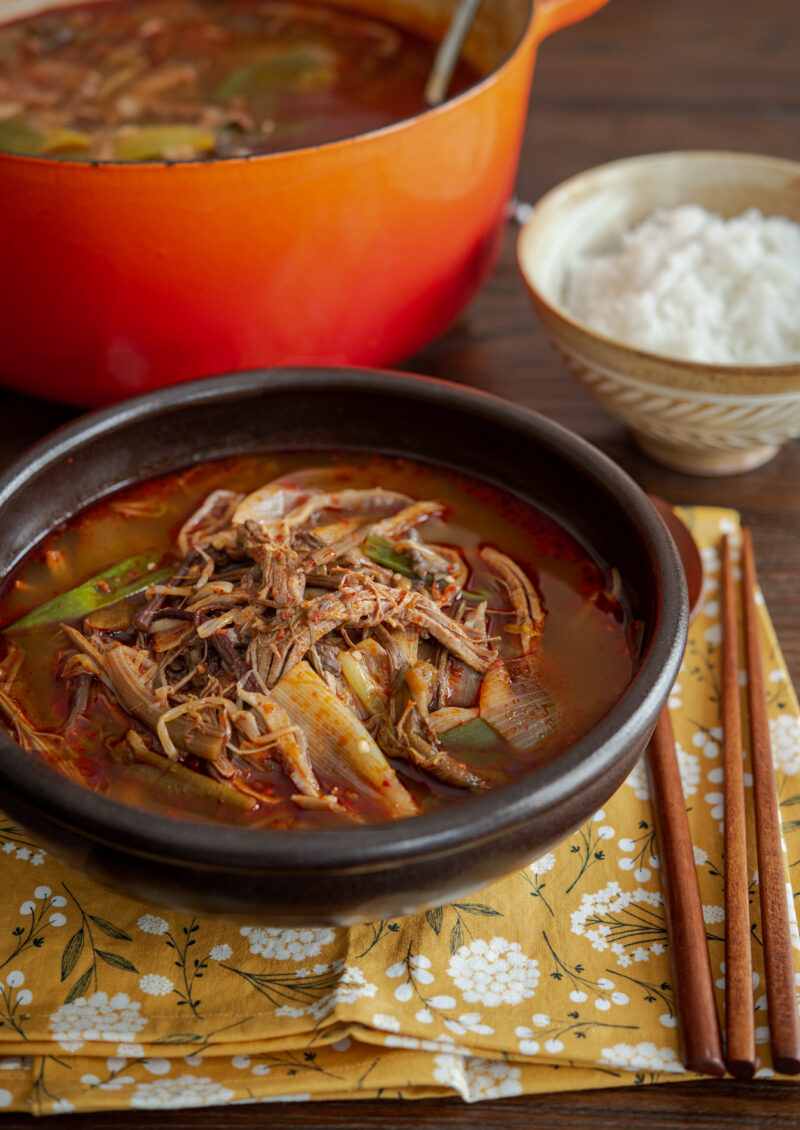
This recipe was originally posted in December 2012. I've updated the recipe with a few changes, new photos, and more information.
More Comfort Soups
Soups bring a comfort to our body and mind. Korean soup recipes are not an exception. Here are a few that I love and I hope you will love, too.
- Korean Beef Radish Soup (Sogogi Muguk)
- Spicy Korean Chicken Soup (Dakgaejang)
- Beef and Bean Sprout Soup
- Korean Turnip Green Soup with Potato
- Soybean Sprout Soup with Kimchi
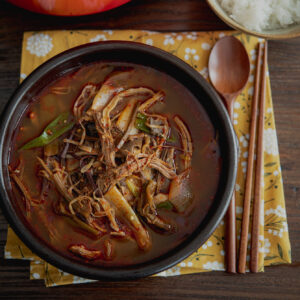
Korean Spicy Beef Vegetable Soup (Yukgaejang)
This authentic homemade recipe for Yukgaejang (spicy Korean beef vegetable soup) is deeply flavorful and comforting. I've included step-by-step photos and my top tips for making this satisfyingly spicy beef stew at home in your own kitchen.
For beef stock
- 1 1/4 lb beef brisket
- 1 large onion , cut in half
- 1 whole garlic , cut in half
- 1/2 lb Korean radish, cut into large chunks
- 14 cups water
To re-hydrate the dried vegetables
-
Add fernbrake in a pot filled with water. Bring it to a gentle boil and simmer for 20 minutes. In another pot, cook the taro stem using the same method. Let it soak in the pot for 1 hour as well. Remove each pot from the heat and let vegetables to soak in the pot, covered, for 1 hour.
-
Drain the dried vegetables and rinse them in cold water several times. Squeeze out the extra water from the vegetables. Cut fernbrake and taro stem in 2-inch slices.
To make the beef stock
-
In a stock pot, combine onion, whole garlic (cut in half), chunks of radish and beef brisket. Add 14 cups of water to the pot and bring it to a gentle boil. Reduce the heat to low and let it simmer for 45 minutes.
-
Discard the vegetables and reserve the beef. Strain the stock in a skimmer to collect any small particles. Reserve the stock.
-
When the beef is cooled to touch, shred the beef into bite size pieces.
To blanch the fresh vegetables
-
For the Asian leeks, cut them in half lengthwise, then cut into 2-inch slices. As an optional step, remove the pale green core in the center of the white parts of the leeks because they tend to be tough. You can leave it the way it is, if you wish.
-
Bring a large pot of water to boil and sprinkle some salt. Add mungbean sprouts, stir, and wait for 10 seconds.
-
Add oyster mushroom and leek slices. Cook the vegetables for 10 more seconds. Drain and rinse the vegetables in cold running water. Squeeze out the extra water.
To make the beef soup (Yukgaejang)
-
Heat oil and sesame oil in a large pot over low heat. Add the Korean chili flakes and stir it for 30 seconds to release the fragrance and infuse the oils.
-
Add the vegetables and beef into the pot. Stir well to coat them with the chili oil. Pour the reserved stock into the pot. The amount of stock could be between 8-10 cups, depending on how thin you want your stew to be.
-
Add a teaspoon of Korean chili paste (gochujang) into the stew and mix well. Chili paste will help your stew to maintain its redness of broth without going dull. Cover the pot and let the stew simmer for 15-20 minutes over med-low heat.
-
Season the stew with 3 different Korean sauces; soy sauce, Korean soup soy sauce, and Korean anchovy sauce. Taste the broth and add some salt, if needed. Lastly sprinkle with lots of black pepper according to your taste.
Tag @beyondkimchee on Instagram. I love to see your masterpiece.
Source: https://www.beyondkimchee.com/yukgaejang/
0 Response to "Spicy Korean Beef Stew Cooks Illustrated"
Postar um comentário